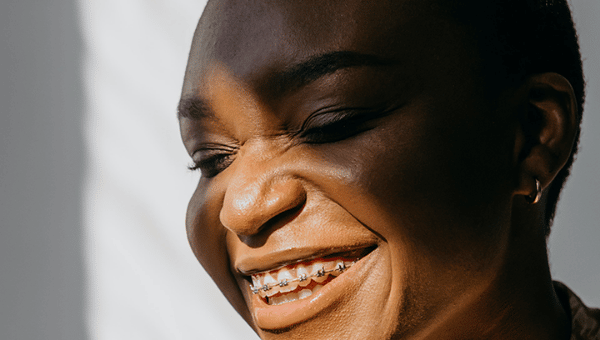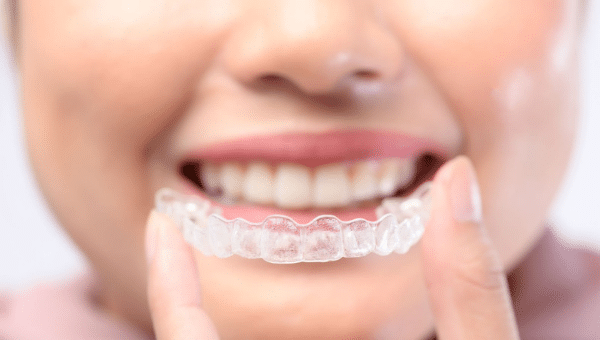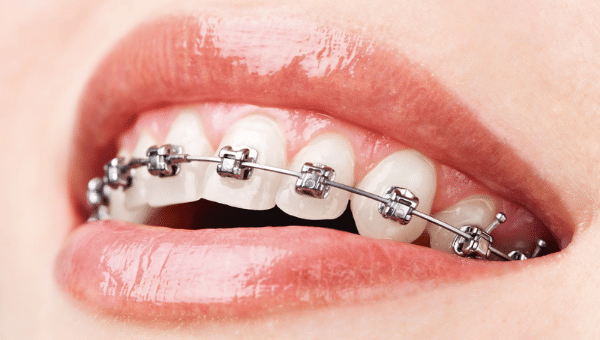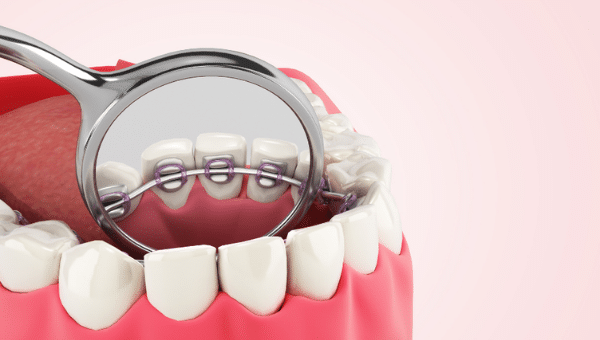6 Types of Braces: Costs, Pictures, Benefits
Everyone wants a perfect smile. But with so many types of braces on the market, it can be hard to determine which option is best for you.
There are 5 main types of braces:
- Metal Braces
- Ceramic Braces
- Invisible Braces
- 3D Printed Braces
- Self-Ligating Braces
- Lingual Braces
In this article, we’ll compare the different types of braces with their pros and cons. While this list will give you an overview of your options, visit your orthodontist before making a final decision.
Conventional Metal Braces

Suitable for: children, teens, and adults.
While traditional “wire-and-bracket” braces used to be bulky, modern braces have become smaller, less noticeable, and more comfortable.
Conventional braces use metal brackets, wires, and elastic bands to “push” misaligned teeth into the correct position. Every 4 to 6 weeks, an orthodontist adjusts the wire to “tighten” the braces.
With an average price range of $3,000 to $6,000, metal braces are the most affordable option for straightening teeth.
Advantages of metal braces:
- Can treat even the most complex cases.
- Elastic bands come in a wide variety of fun colors.
Disadvantages of metal braces:
- More noticeable than alternatives.
- May be challenging to keep clean.
- Patients have food restrictions.
Ceramic Braces

Suitable for: teens and adults.
Ceramic braces have the same design as metal braces, but the brackets are made of ceramic material that matches the color of natural teeth. Like their metal counterpart, ceramic braces require an orthodontist visit every 4 to 6 weeks.
With an average price range of $4,000 to $8,000, ceramic braces are a popular and affordable alternative to metal braces.
Advantages of ceramic braces:
- Can treat a wide variety of cases.
- Brackets are smoother and stronger.
- Less noticeable than metal braces.
- Typically require less time than aligners.
Disadvantages of ceramic braces:
- Slightly larger than metal braces.
- Elastic bands can stain easily.
- May be challenging to keep clean.
- Patients have food restrictions.
Invisible Braces

Suitable for: teens and adults.
Invisalign is a system of clear plastic aligners that are custom-made to fit over the teeth. Patients typically wear their aligner for 20 to 23 hours a day, only removing it for meals and cleaning teeth. Like metal braces, Invisalign treatment requires an office visit every 10 to 14 weeks.
With an average price range of $3,000 to $7,000, clear aligners may cost even less than traditional braces. However, many insurance policies cover Invisalign to the same extent as braces.
Advantages of Invisalign:
- Clear and transparent.
- Customized for your mouth.
- Comfortable.
- Removable.
- Easy to keep clean.
- No food restrictions.
- Many times – faster than braces when treated by an experienced, knowledgeable orthodontist.
Disadvantages of Invisalign:
- It is up to the patient to make sure they were the aligners in order to get the results they expect.
3D Printed Braces – LightForce Braces

Suitable for: teens and adults.
LightForce takes a truly individualized approach to straightening teeth. While conventional braces use pre-made brackets, LightForce uses 3D-printed brackets that are customized to fit your smile with 100% precision.
LightForce braces are designed to be more comfortable and less bulky than traditional braces. They are made of flexible material, and they also have a rubber lining on the inside for maximum comfort.
Advantages of 3D-Printed Braces:
- Customized for your mouth.
- Comfortable.
- Faster application.
- Reduced treatment time.
- Fewer office visits.
- Less noticeable than metal braces.
Disadvantages of 3D-Printed Braces:
- Slightly more expensive than traditional braces.
Self-ligating Braces

Suitable for: children, teens, and adults.
Self-ligating braces use brackets and clips to form a sliding mechanism. This system allows the wire to move on its own, producing faster results without the need for elastic bands.
While materials are more expensive, self-ligating braces only require adjustments every 8 to 12 weeks. This keeps the average price range at $4,000 to $7,000.
Advantages of self-ligating braces:
- Shorter & fewer appointments.
- Faster results.
- Less friction / less discomfort.
- Easier to keep clean.
Disadvantages of self-ligating braces:
- Bracket design may offer less precision.
- May be challenging to keep clean.
- Patients have food restrictions.
Lingual Braces

Suitable for: older teens and adults
Also known as “inside” braces, lingual braces use custom-made brackets which are attached to the backside of each tooth. A wire connects the brackets and “pulls” misaligned teeth into position. Typically, lingual braces need adjustments every 6 to 8 weeks.
With an average price range of $5,000 to $11,000, lingual braces typically cost more than other available options.
Advantages of lingual braces:
- Virtually invisible.
- Customized for your mouth.
- Less risk of decalcification.
- Easier to keep clean.
Disadvantages of lingual braces:
- Not appropriate for severe cases.
- May take longer to deliver results.
- Challenging to keep clean.
- Appointments take longer.
- May affect speech for the first few weeks.
- May irritate the patient’s tongue.
Which Type of Braces Should You Choose?
In the modern era of orthodontics, patients have more choices than ever. So how can you ensure that you make the right choice for braces?
Beyond aesthetic concerns, the treatment you need depends on what your teeth need, what you do with them, and how much you’re willing to spend.
It’s important to remember that no two mouths are exactly alike. Not only are our teeth different, but our faces and jaws are too. That’s why ideal braces for one patient may not be the best option for another.
If you’re considering braces, visit a board-certified orthodontist for a thorough consultation. After examining your case, the orthodontist will tell you which options are right for your needs.
Having braces can help you have a smile that you’re proud of! Contact Let’s Smile Dental today to schedule an appointment.
Since Let’s Smile is very experienced with Invisalign, the doctors at Let’s Smile treat more difficult cases with Invisalign than others. Make sure you visit one of their doctors to discuss your Invisalign treatment.


